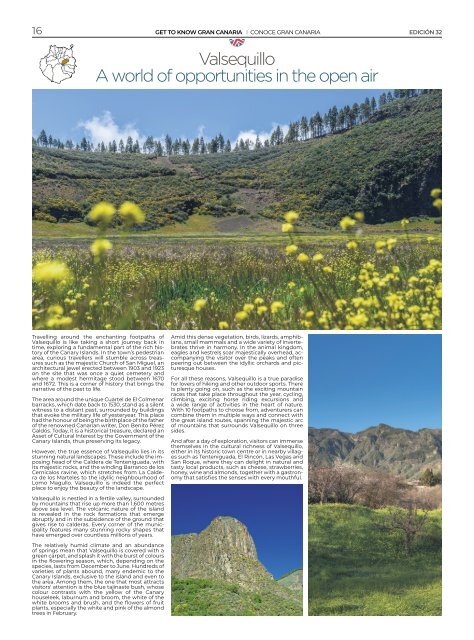No. 32 - Its Gran Canaria Magazine
Rutas, recomendaciones y noticias de Gran Canaria. Routes, tips and news about Gran Canaria.
Rutas, recomendaciones y noticias de Gran Canaria.
Routes, tips and news about Gran Canaria.
Create successful ePaper yourself
Turn your PDF publications into a flip-book with our unique Google optimized e-Paper software.
16<br />
GET TO KNOW GRAN CANARIA I CONOCE GRAN CANARIA EDICIÓN <strong>32</strong><br />
Valsequillo<br />
A world of opportunities in the open air<br />
Travelling around the enchanting footpaths of<br />
Valsequillo is like taking a short journey back in<br />
time, exploring a fundamental part of the rich history<br />
of the Canary Islands. In the town’s pedestrian<br />
area, curious travellers will stumble across treasures<br />
such as the majestic Church of San Miguel, an<br />
architectural jewel erected between 1903 and 1923<br />
on the site that was once a quiet cemetery and<br />
where a modest hermitage stood between 1670<br />
and 1672. This is a corner of history that brings the<br />
narrative of the past to life.<br />
The area around the unique Cuartel de El Colmenar<br />
barracks, which date back to 1530, stand as a silent<br />
witness to a distant past, surrounded by buildings<br />
that evoke the military life of yesteryear. This place<br />
had the honour of being the birthplace of the father<br />
of the renowned <strong>Canaria</strong>n writer, Don Benito Pérez<br />
Galdós. Today, it is a historical treasure, declared an<br />
Asset of Cultural Interest by the Government of the<br />
Canary Islands, thus preserving its legacy.<br />
However, the true essence of Valsequillo lies in its<br />
stunning natural landscapes. These include the imposing<br />
head of the Caldera de Tenteniguada, with<br />
its majestic rocks, and the winding Barranco de los<br />
Cernícalos ravine, which stretches from La Caldera<br />
de los Marteles to the idyllic neighbourhood of<br />
Lomo Magullo. Valsequillo is indeed the perfect<br />
place to enjoy the beauty of the landscape.<br />
Amid this dense vegetation, birds, lizards, amphibians,<br />
small mammals and a wide variety of invertebrates<br />
thrive in harmony. In the animal kingdom,<br />
eagles and kestrels soar majestically overhead, accompanying<br />
the visitor over the peaks and often<br />
peering out between the idyllic orchards and picturesque<br />
houses.<br />
For all these reasons, Valsequillo is a true paradise<br />
for lovers of hiking and other outdoor sports. There<br />
is plenty going on, such as the exciting mountain<br />
races that take place throughout the year, cycling,<br />
climbing, exciting horse riding excursions and<br />
a wide range of activities in the heart of nature.<br />
With 10 footpaths to choose from, adventurers can<br />
combine them in multiple ways and connect with<br />
the great island routes, spanning the majestic arc<br />
of mountains that surrounds Valsequillo on three<br />
sides.<br />
And after a day of exploration, visitors can immerse<br />
themselves in the cultural richness of Valsequillo,<br />
either in its historic town centre or in nearby villages<br />
such as Tenteniguada, El Rincón, Las Vegas and<br />
San Roque, where they can delight in natural and<br />
tasty local products, such as cheese, strawberries,<br />
honey, wine and almonds, together with a gastronomy<br />
that satisfies the senses with every mouthful.<br />
Valsequillo is nestled in a fertile valley, surrounded<br />
by mountains that rise up more than 1,600 metres<br />
above sea level. The volcanic nature of the island<br />
is revealed in the rock formations that emerge<br />
abruptly and in the subsidence of the ground that<br />
gives rise to calderas. Every corner of the municipality<br />
features many stunning rocky shapes that<br />
have emerged over countless millions of years.<br />
The relatively humid climate and an abundance<br />
of springs mean that Valsequillo is covered with a<br />
green carpet, and splash it with the burst of colours<br />
in the flowering season, which, depending on the<br />
species, lasts from December to June. Hundreds of<br />
varieties of plants abound, many endemic to the<br />
Canary Islands, exclusive to the island and even to<br />
the area. Among them, the one that most attracts<br />
visitors' attention is the blue tajinaste bush, whose<br />
colour contrasts with the yellow of the Canary<br />
houseleek, laburnum and broom, the white of the<br />
white brooms and brush, and the flowers of fruit<br />
plants, especially the white and pink of the almond<br />
trees in February.
















